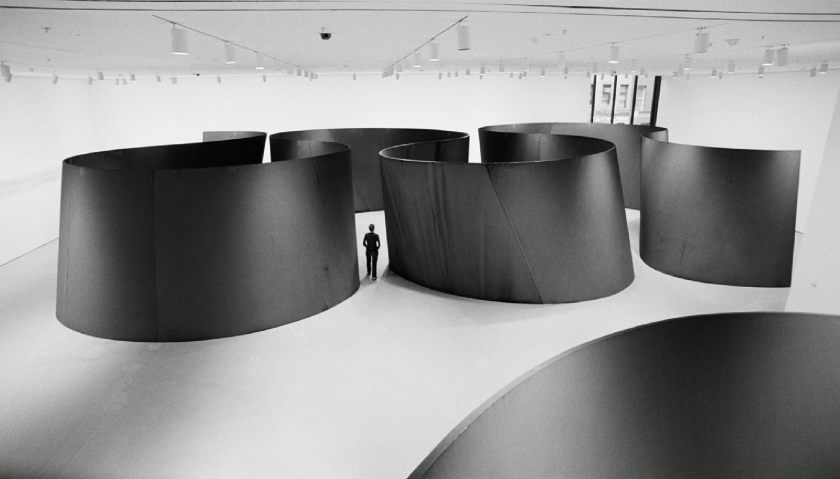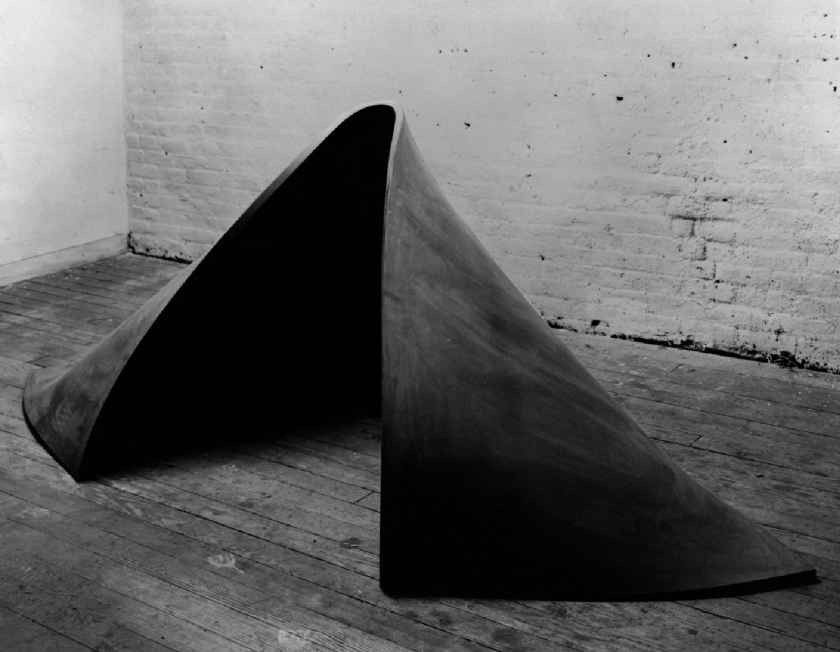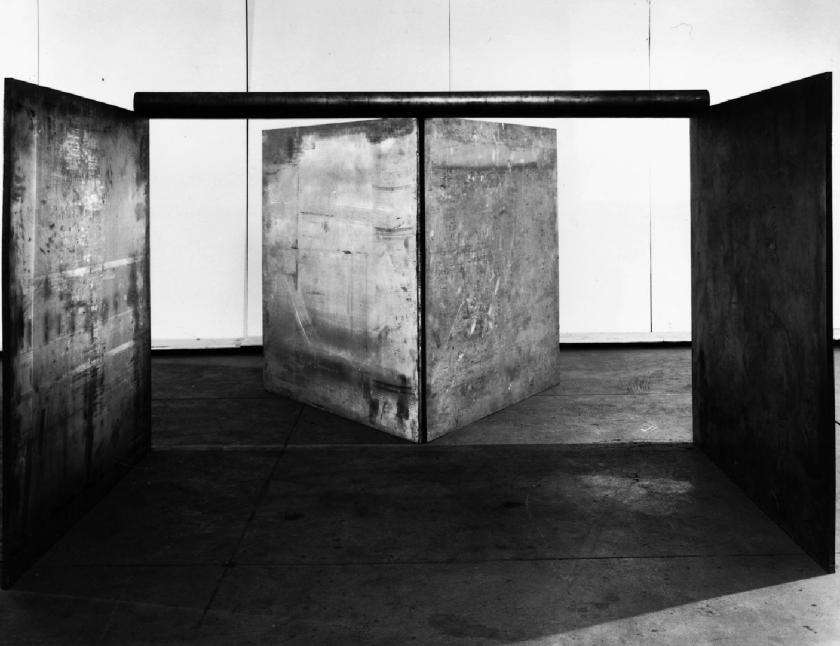(VERY) SHORT BIO | Richard Serra (San Francisco, 1939) is the second of three brothers: his father was Spanish, native of Mallorca, while his mother was a Russian Jewish immigrant from Odessa. He is both sculptor and video artist, well known for large scale artworks, usually made of sheet metal. Richard Serra was also involved in the Process Art Movement.
Steel memories
He studied English literature firstly at the University of California Berkeley that in Santa Barbara, where he graduated with a B.A in 1961.
> To support himself and his studies, he worked in steel mills.
This experience, along with the memories of the shipyard where his father worked as a pipe-fitter, extremely influenced his later work as artist.
“All the raw material that I needed is contained in the reserve of this memory which has become a reoccurring dream.”
(Richard Serra)
Studies
Between 1961 and 1964 he studied painting at Yale University School of Art and Architecture, where he found many sources of inspiration. In fact, his greatest influencers were his very professors: artist Philip Guston and experimental composer Morton Feldman are perhaps the most important.
Travelling
Once he graduated, he decided travel. So he spent one year in Florence and one in Paris. Thanks to a Fulbright Scholarship, he then moved to Rome with his wife, Nancy Graves.
New York and the first works
Back to the US, he set his studio in New York where his circle of friends included Carl Andre, Walter de MAroa, Eva Hesse, Sol LeWitt and Robert Smithson. In 1966, he used rubber for the first time and he began his experimentation with lead in 1968: a discovery which will shape his whole career.
> Low Rate Movers is the name of the furniture-removals business he started to fund his work. Among his employees: Chick Close, Philip Gras and Spalding Grey.
Unconventional materials
His first works stood out because of their unconventional materials, such as fiberglass and rubber. These sculptures where totally abstract and process-based, made of molten lead hurled in large splashes against the wall of a studio or exhibition space.
The infinitive dictionary
For his works, he also elaborated a special dictionary, made of made-up verbs: “tu hurl” suggested the hurling of molten lead into crevices between wall and floor “to roll” suggested the rolling of the materials into dense, metal logs Then, he became interested in lead sheets and rough timber, so he started “to cut”, “to prop” and “to stack” to transform these materials into structures supported by their own weight
Site specific artworks
Using large rolls and sheets of metal he started working on a his series of huge outdoor and site specific artworks, that provided him worldwide notoriety. In spite of their weird anti anti-gravity shapes, the sculpture are often self-supporting, emphasizing the weight and the nature of the material.
A-specific material: corten
In one side his work are site specific, because of their shapes and because of the process that led to their realisation, while the material is totally a-specific. In fact, he often uses corten, a special steel that easily adapted to every environment. When exposed to air, corten starts an ossidation process that covers itself with a protective film, very similar to a patina of rust.
CORTEN | Cor-Ten steel was designed to acquire a dark, even patina of rust over time. The surface of the steel sculptures go through an initial oxidation process and after 8–10 years, the patina of the steel settles to one color (usually brown). This color will last relatively stable over the piece's life.
The viewers’ perception
With these works, Richard Serra wants to challenge the viewers’ perception of their bodies, sometimes in relation to the interior space carved inside the sculptures, sometimes with the landscape of his site specific and land art sculptures. Their dimensions usually dwarfs people, both inside and outside.
The importance of maquettes
Richard Serra sculptures starts from 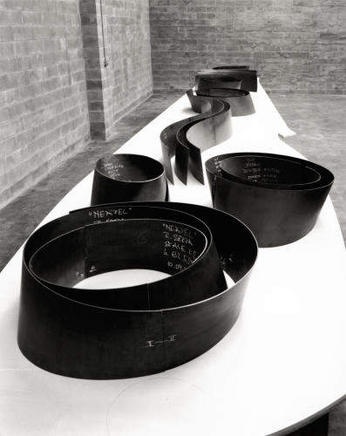 maquettes. Usually he makes that with a malleable material, leads is one of his favorites, so that he can continuously rework on ideas and shapes, to reach the final form. Other materials he uses are steel and, sometimes, wood >> He uses to work at an inch to foot ratio: if the sculpture he is working on is going to be 30 foot long, he composes a 30-inches model.
maquettes. Usually he makes that with a malleable material, leads is one of his favorites, so that he can continuously rework on ideas and shapes, to reach the final form. Other materials he uses are steel and, sometimes, wood >> He uses to work at an inch to foot ratio: if the sculpture he is working on is going to be 30 foot long, he composes a 30-inches model.
Selected Works
Torqued Ellipse
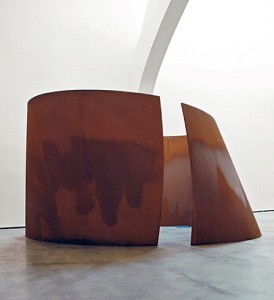 One of his most famous series is the “Torqued Ellipse”, inspired by the baroque church San Carlo alle Quattro Fontane designed by the Italian artist Francesco Borromini. The series began in 1996 with a single elliptical form; made of huge steel plates bent into circular sculptures with open tops, they rotate award as they lean in or out. After making some wooden models, Serra consulted a structural engineer, to better understand how pieces should be made to support themselves and to keep their balance. All steel pieces (corten, more precisely) were fabricated in Germany.
One of his most famous series is the “Torqued Ellipse”, inspired by the baroque church San Carlo alle Quattro Fontane designed by the Italian artist Francesco Borromini. The series began in 1996 with a single elliptical form; made of huge steel plates bent into circular sculptures with open tops, they rotate award as they lean in or out. After making some wooden models, Serra consulted a structural engineer, to better understand how pieces should be made to support themselves and to keep their balance. All steel pieces (corten, more precisely) were fabricated in Germany.
Tilted Arc
Placed in the Federal Plaza in New Yourk City, “Tilted Arc” is a soft and curvy arch (3,5 meter high) made of rusting mild steel. Since the very first day, there were many controversies about the installation, especially because people living and working in the neighborhood though that the giant wall could obstruct the passage through the plaza. In 1985, people voted to move the work away from the plaza. But the sculpture is site specific and, as Serra claimed, it can’t be moved. In 1989 the sculpture was dismantled and cut into three parts, then consigned to a New York warehouse. They were finally moved to a storage space in Maryland in 1999.
“To remove the work is to destroy it”
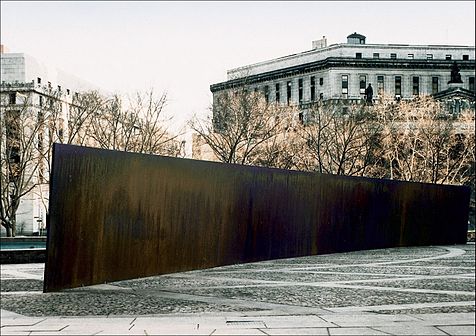 The Tilted Arc’s events were satirized by William Gaddis in his novel “A Frolic of His Own”. A huge sculpture has to be destroyed because a dog got entrapped inside it. Mr Szyrk, the artist, firmly rebels against this decision and is granted a preliminary injunction by the judge.
The Tilted Arc’s events were satirized by William Gaddis in his novel “A Frolic of His Own”. A huge sculpture has to be destroyed because a dog got entrapped inside it. Mr Szyrk, the artist, firmly rebels against this decision and is granted a preliminary injunction by the judge.
The Matter of Time
The Matter of Time was mounted in the Guggenheim Museum of Bilbao in 2005. The whole work is composed by 8 sculptures that measures about 4 meters in height and weights from 44 to 276 tons. It includes one of Serra’s most famous works: the enormous sculpture Snake, a trio of sinuous steel sheets that creates a curving path. 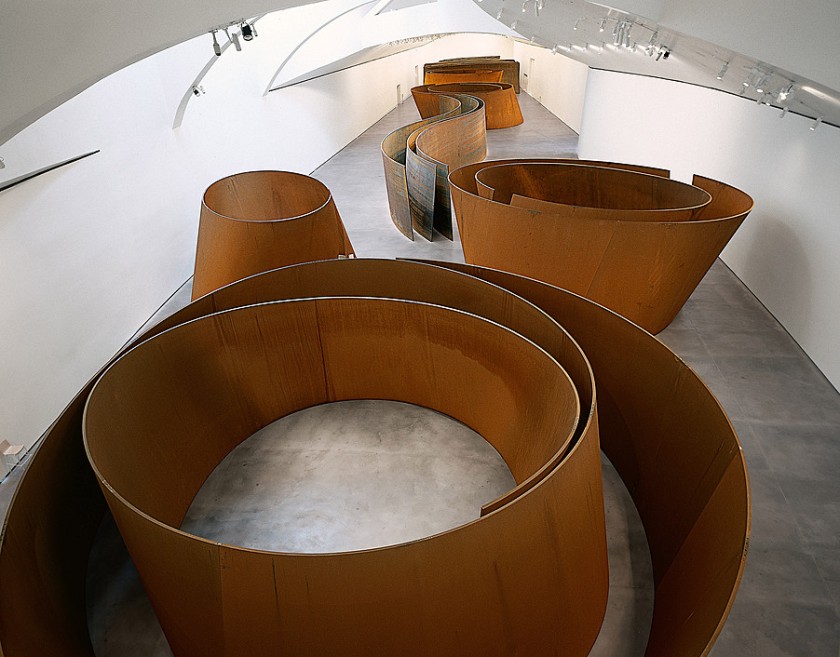
Memorials
Richard Serra also realized several Memorials. “Berlin Junction”, designed in 1987 for those ho died during the Nazis’ genocide, was firstly shown at the Martin-Gropius-Bau, then installed at the Berliner Philharmonie. He designed “Gravity” for the United States Holocaust Memorial Museum and he was supposed to work with Peter Eisenmann to submit a design for Berlin’s Memorial to the Murdered Jewish of Europe, but then he left the project.
Video Art
Richard Serra also produced some videos; his first one, named “Hand Cathing Lead” features a single shot of an hand in an attempt to repeatedly catch pieces that are dropped from the top of the frame. The film has a fixed rate of 24 frames per second that gives an illusion of continuity; the fall of pieces echoes the movement of the film through the projector, while the hand, opening and closing continuously, scans and articulates the advance of the film. Moreover, the hand, when shadowed by the piece of lead, resembles the silhouette of a dog trying to catch something; this is a reference to the origins of cinema, as art of shadow theatre.
Drawings
The attention of Serra was not focused on sculptural works or videos but also on large-scale drawings, especially on handmade Hitomi paper or Belgian linen, using various techniques. For his first works he used paintsticks (wax-like grease crayons). > Only a few of Serra’s top auction prices are for sculpture; the rest are for his works on paper.
When representing his site specific artworks and sculptures, drawings are not always preparatory studies: sometimes they are realized after their completation: a form of notating and verifying their spatial relationships. In the 70s, Serra made his first “Installation of Drawings”, realized with several works of canvas or linen pinned directly on the wall and thickly covered with black painstick.
Not only a sculptor, Richard Serra is an eclectical artist. His out of reach ability to link site, art and viewer makes him one of the most recognized artist of our time.
Photos and images from:
Metropolis Guggenheim Gallery Gagosian Gallery MoMA United States Holocaust Memorial Museum Art Observed
